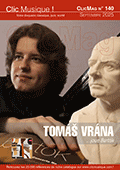 Véritable énigme que ce Gaspard le Roux. Est-ce le nom d’un « petit maître » ? Ou s’agit-il , comme on le suppose souvent, du pseudonyme d’ un compositeur connu? Le nom ne figure que dans une liste de professeurs parisiens réputés , et sur la partition de l’ œuvre, modeste par sa taille mais d’une qualité égalant, par son inventivité, son ingéniosité et sa prestance, celles des grandes figures du temps. D’où l’intérêt qu’elle suscite. Cette musique innove : elle offre, pour la plupart des suites, un dispositif d’interprétation qu’on dirait aujourd’hui à « géométrie variable » . Sur des portées supplémentaires est proposée une alternative, qui, redistribuant et complémentant le matériau permet d’ajouter un second clavecin au premier — procédé tout à fait inédit alors. Cet enregistrement est le seul à offrir, pour l’une des suites, les deux réalisations : l’auditeur saisit ainsi avec quelle subtilité, dans la version à 2 instruments, les trames s’interpénètrent, se chevauchent, se superposent, et comment un jeu d’arpèges, la suggestion d’un orchestre, d’une danse dans la danse, sur le deuxième instrument, accentuent, infléchissent, projettent, relancent ou rendent plus ductile le propos « initial». Dans les autres pièces, version à un seul et à deux instruments alternent. Interprétation variée, animée, énergique , équilibrée et sans aucune surcharge (ce qui n’est pas évident avec 2 clavecins). Un élan constamment renouvelé, un sens de la danse, une respiration ample et naturelle. Remarquable. (Bertrand Abraham)  The life and times of Gaspard le Roux are more than usually shrouded by the mists of time. He died in Paris, around 1707. Much else is guesswork. By that time he had become among the most renowned keyboard players in Paris, handsomely paid both for his compositions and his performances. As was common, he wrote music to play himself; the identification between composer and performer was as strong as it later became again in the 20th century with the advent of popular singersongwriters. The suites on this new recording were first issued by the distinguished publisher Etienne Roger, who also acted as an agent and promoter for Handel, among others. They are written as a richly ornamented sequence of dances, by turns measured and sprightly, full of courtly manners but at the same time not overlaid with formality. Having consulted the manuscript sources, Pieter-Jan Belder has devised his own ordering of the suites, more complete than most other recorded versions. He has taken a view on the flexible structure of the original suites, which allows for them to be played solo, with another harpsichord or as trio sonatas with another melody instrument and a basso continuo. However, as van Belder points out in his own engaging booklet notes, ‘nowadays not so many people have two harpsichords at their disposal to be able to play these pieces at home with their friends. That is what we enjoyed most while preparing this recording. Imagine two middle-aged men enjoying a glass of wine and a cigar (although we don’t smoke) and playing two beautiful harpsichords instead of playing chess or or discussing life. You will then have the picture.’ Van Belder has made many albums for Brilliant Classics during the last two decades, including the peaks of the Baroque keyboard repertoire by J.S. Bach, Domenico Scarlatti, Soler and many others. He is presently engaged on the mammoth project of recording the complete Fitzwilliam Virginal Book, of which the fourth volume (BC95254) was released earlier this year.
 |
